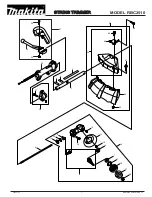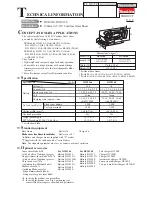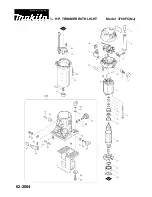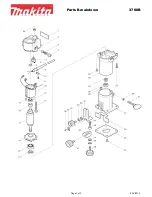
5. Repeat above step with second
line
(
38
), using the
bottom part of spool. Do not overfill.
6. Replace the spool and the
bump knob
. Refer to
"Spool Replacement " earlier in this manual.
MAINTENANCE
CLEANING THE EXHAUST PORT AND MUFFLER
Depending on the type of fuel used, the type and amount of
oil used, and/or your operating conditions, the exhaust port
and muffler may become blocked with carbon deposits. If
you notice a power loss with your
petrol
powered tool, a
qualified service technician will need to remove these
deposits to restore performance.
SPARK ARRESTOR
The spark arrestor must be cleaned or replaced every 25
hours or yearly to ensure proper performance of your
product. Spark arrestors may be in different locations
depending on the model purchased. Please contact your
nearest service dealer for the location of the spark arrestor
for your model.
Cleaning Instructions:
Remove the spark arrestor from the muffler.
If your spark arrestor is made of a fiberglass material,
discard and replace.
If your spark arrestor is made of a metal material follow
these cleaning instructions:
1. Spray the spark arrestor with a quality carbon
cleaner.
2. Gently clean using a wire brush.
3. Install the new or cleaned spark arrestor and reas-
semble completely before use.
REPLACING AND CLEANING AIR FILTER (FIG. 16 & 17)
For proper performance and long life, keep air filter clean.
1. Remove the air filter cover by pushing down on the latch (
39
)
with your thumb while gently pulling on the cover (4
0
).
2. Remove the filter (4
1
), clean it in warm soapy water. Rinse
and let dry completely. For best performance, replace
annually.
3.
Install the filter, align tabs, push in, and make sure the
The fuel cap
(
48
)
contains a non-serviceable filter and a check
valve. A clogged fuel filter will cause poor engine perfor-
mance. If performance improves when the fuel cap is
loosened, check valve may be faulty or filter clogged.
Replace fuel cap if required.
SPARK PLUG
This engine uses a Champion RCJ-6Y
and NGK BPMR7A
with 0.63 mm
electrode gap. Use an exact
and replace
replacement
annually.
WARNING:
FUEL CAP
A leaking fuel cap is a fire hazard and must be
replaced immediately.
3. Cut two pieces of string, each being approximately
2.7 m long.
4. Insert the first
line
(
37
) into the anchor hole (4
7
) in the
upper part of the spool. Wind the first
line
around
the upper part of the spool counterclockwise, as
shown by the arrows on the spool (3
1
). Place
line
in
the slot on upper spool flange, leaving about 152
mm extended beyond the slot. Do not overfill.
After winding the
line
, there should be at least 6
mm between the wound
line
and the outside edge
of the spool.
latches are locked into place.
6. Make sure the
bump
head and the
bump knob
are
installed on the drive connector by turning the
knob
counter-
clockwise to tighten.
7. Pull the
line
s again to rotate the spool into cutting
position. Push the
bump knob
down while pulling on
line
(s) to manually advance the
line
and to check for
proper assembly of the
bump
head.
3. To install the new spool, make sure the two
line
s are
captured in the slots (3
4
) opposite each other on the new
spool. Make sure the ends of each string is extended
approximately 152 mm beyond each slot.
4. Thread the
line
s into the eyelets (3
2
) in the
bump
head.
Carefully push the spool into the
bump
head (gently pull
the
line
s to the outside if necessary). When the spool
is positioned in the
bump
head, grasp the
line
s and
pull sharply to release them from the slots in the spool.
5. Push down and turn the spool counterclockwise until it
no longer turns. Hold the spool down and rotate clock-
wise a small amount. Release the spool. The spool
should be locked down in the
bump
head. If not, hold
down and rotate until locked.
LINE
REPLACEMENT (FIG. 12 - 15)
1. Stop the engine, disconnect the spark plug wire.
Hold the
bump
head and unscrew the
bump knob
.
Turn clockwise.
2. Remove the spool from the
bump
head.
NOTE:
Keep the spring attached to the spool. Remove any
old
line
remaining on the spool.
- 6 -
Summary of Contents for PLT-3043YW
Page 1: ...PLT 3043YW TRIMMER OWNER S OPERATION MANUAL N197 ...
Page 3: ...Fig 7 Fig 9 Fig 10 Fig 8 5 4 3 Fig 6 29 28 27 30 20 Fig 11 32 31 35 34 33 32 16 17 18 19 15 ...
Page 4: ...Fig 13 Fig 14 Fig 15 Fig 12 35 31 36 47 37 37 41 38 36 34 Fig 16 39 40 Fig 17 41 42 43 ...
Page 5: ...Fig 18 44 45 46 ...
































